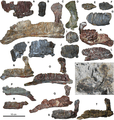Dental battery
A dental battery was a rough mesh of teeth used in the herbivorous hadrosaur, neoceratopsian, and rebbachisaurid dinosaurs.

Description
Hadrosaurids are the only dental battery examined in detail to date, studied in 2017. A battery was a dense formation of tightly packed teeth connected by flexible connective tissues along the jaw, but not fused as traditionally believed.[1] The battery had a similar texture to medieval scale armour or shark skin denticles. It generally fossilises.[2]
Teeth were organised into tooth families. With four to six teeth per family, and up to 60 tooth families, there were about 300 teeth total. Each family created a deep ridge in the bone beneath, giving the inner jaws a comb-like appearance. New tooth growth was rapid and continuous (polyphyodont), meaning a hadrosaur could grind a tooth down completely while a replacement grew up from behind. New teeth formed in the back and moved to the front of the mouth.[1][2]
An individual tooth was flat and blade-like, with a ridge along the top, making the hadrosaur battery appear as rows of scales and ridges. Enamel coated only one side of the tooth. Cementum which was unusually thick and uniquely vascular. Dentine in hadrosaurs was also vascular. Teeth were angled towards the front of the mouth in hatchlings, and, with maturity, frontward teeth became more frontwardly angled, and rearward teeth more rearwardly angled.[1][2]
Hadrosaurids probably chewed with a backward and slightly circular motion of the lower jaw (palinal chewing).[1][2] There is no modern analogue, so its evolution is unclear.[1] However, the battery is believed to have been an advantage contributing to hadrosaur domination of the era.[3]
Gallery
 Pararhabdodon
Pararhabdodon Unidentified lambeosaurine
Unidentified lambeosaurine- Amurosaurus
.jpg) Nigersaurus
Nigersaurus Adult and juvenile hadrosaur jawbones
Adult and juvenile hadrosaur jawbones Nigersaurus
Nigersaurus Closeup of Edmontosaurus
Closeup of Edmontosaurus
See also
- Dinosaur teeth
- Glossary of dinosaur anatomy
- Timeline of hadrosaur research
References
- Bramble, Katherine; LeBlanc, Aaron R. H.; Lamoureux, Denis O.; Wosik, Mateusz; Currie, Philip J. (17 November 2017). "Histological evidence for a dynamic dental battery in hadrosaurid dinosaurs". Scientific Reports. 7 (1). doi:10.1038/s41598-017-16056-3.
- LeBlanc, Aaron R. H.; Reisz, Robert R.; Evans, David C.; Bailleul, Alida M. (28 July 2016). "Ontogeny reveals function and evolution of the hadrosaurid dinosaur dental battery". BMC Evolutionary Biology. 16 (1). doi:10.1186/s12862-016-0721-1. PMC 4964017. PMID 27465802.
- Bardin, Jon (4 October 2012). "Duck-billed dinosaurs had hundreds of complex teeth". Los Angeles Times.